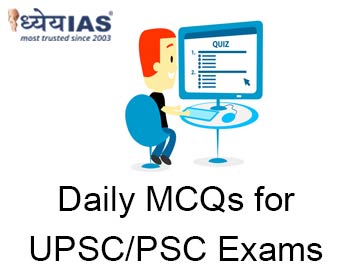Home > Daily-mcqs
Daily-mcqs 21 Aug 2024

Q1:
Which of the following statements about waterspouts is correct?
A: Non-tornadic waterspouts are usually associated with severe thunderstorms.
B: Tornadic waterspouts are associated with severe thunderstorms and are less common.
C: Waterspouts can occur only in tropical and subtropical regions.
D: All waterspouts are equally dangerous to ships.
Answer: B
Explanation:
Tornadic waterspouts are really rare and are formed with severe thunderstorms, similar to tornadoes on land. On the other hand, non-tornadic waterspouts are weak and usually form in fair weather, not with severe thunderstorms. Waterspouts can occur in both tropical and temperate regions, and while all waterspouts pose some risk to watercraft, tornado waterspouts are particularly dangerous.
Q2:
Which of the following statements about the climatology of waterspouts is true?
A: Waterspouts are most common in polar regions.
B: Waterspouts are most often seen on inland mountain lakes.
C: Waterspouts are more common within 100 km of the coast.
D: Waterspouts usually form in winter in the Northern Hemisphere.
Answer: C
Explanation:
Waterspouts are more often seen within 100 km of the coast, especially in tropical and subtropical regions as well as in temperate regions such as the Great Lakes. They are not common in polar regions or in inland mountain lakes, and their peak season in the Northern Hemisphere is not in winter, but in late summer.
Q3:
What was the important outcome achieved during the visit of Malaysian Prime Minister Dato' Seri Anwar Ibrahim to India?
A: Establishment of a military alliance between India and Malaysia
B: Elevation of relations to the level of Comprehensive Strategic Partnership
C: Malaysia's exit from ASEAN
D: Suspension of all trade agreements between India and Malaysia
Answer: D
Explanation:
During the visit of Dato' Seri Anwar Ibrahim to India, Malaysia and India have elevated their relations from the Advanced Strategic Partnership established in 2015 to the Comprehensive Strategic Partnership. This development reflects deep ties, cultural engagement and shared interest in strengthening political, economic, defence and cultural cooperation. This partnership aims to further strengthen relations between the two countries and promote high-level exchanges.
Q4:
During the visit of Malaysian Prime Minister to India, India and Malaysia agreed to enhance cooperation in which area, which focuses on digital infrastructure and emerging technologies?
A: Defence
B: Tourism
C: Digital technologies
D: Traditional medicine
Answer: C
Explanation:
As part of the India-Malaysia Comprehensive Strategic Partnership, the two countries signed a Memorandum of Understanding (MoU) on digital technologies. They agreed to set up the Malaysia-India Digital Council which will focus on cooperation in digital infrastructure and emerging technologies. The initiative is part of broader discussions, also covering areas such as trade, economic cooperation and public administration, aimed at strengthening bilateral ties and addressing the changing digital landscape.
Q5:
What is the primary purpose of the Lokpal and Lokayukta institutions in India?
A: Monitoring the judiciary
B: Investigating and prosecuting corruption among public officials
C: Regulating the financial sector
D: Promoting international trade agreements
Answer: B
Explanation:
The primary purpose of establishing the Lokpal and Lokayukta institutions in India is to investigate and prosecute corruption among public officials. These act as “omnipresent” institutions, which resolve complaints related to corruption at the national (Lokpal) and state (Lokayukta) levels. Their role is important in ensuring transparency and accountability in public administration.